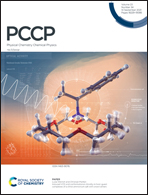On the question of steric repulsion versus noncovalent attractive interactions in chiral phosphoric acid catalyzed asymmetric reactions†
Abstract
The origin of enantioselectivity in asymmetric catalysis is often built around the differential steric interaction in the enantiocontrolling transition states (TSs). A closer perusal of enantiocontrolling TSs in an increasingly diverse range of reactions has revealed that the cumulative effect of weak noncovalent interactions could even outweigh the steric effects. While enunciating this balance is conspicuously important, quantification of such intramolecular forces within a TS continues to remain scarce and challenging. Herein, we demonstrate the utility of the fragment molecular orbital method in establishing the relative contributions of various attractive and repulsive contributions in the total interaction energy between the suitably chosen fragments in enantiocontrolling TSs. Three types of reactions of high contemporary importance, namely, axially chiral phosphoric acid (CPA) catalyzed kinetic resolution of rac-α-methyl-γ-hydroxy ester (reaction I), asymmetric dearomative amination of β-naphthols by dimethyl azodicarboxylate (IIa and IIb), and intramolecular desymmetrization of β,β-disubstituted methyl oxetanes (IIIa) and hydroxyl oxetane (IIIb), bearing a tethered alcohol (–OCH2CH2OH or –(CH2)2CH2OH), are considered. In all the five reactions, the differences in the stabilizing contributions arising due to electrostatic, charge-transfer, and dispersion interactions between the catalyst and the reacting partners in the enantiocontrolling transition states are weighed against the destabilizing exchange interaction. The balancing interactions are found to be between dispersion and exchange repulsion in reaction I, a combination of charge transfer and dispersion energies offsets the repulsive energy in reaction IIb involving the electron rich anthryl groups in the catalyst, whereas the –(CF3)2C6H4 3,3′-substituent in the catalyst (reaction IIa) leads to a trade-off between dispersion and exchange energies. In reactions IIIa and IIIb, however, electrostatic and dispersion energies help compensate the repulsive interactions. These quantitative insights on the intramolecular interactions in the stereocontrolling TSs could help in the rational design of asymmetric catalysis.



 Please wait while we load your content...
Please wait while we load your content...